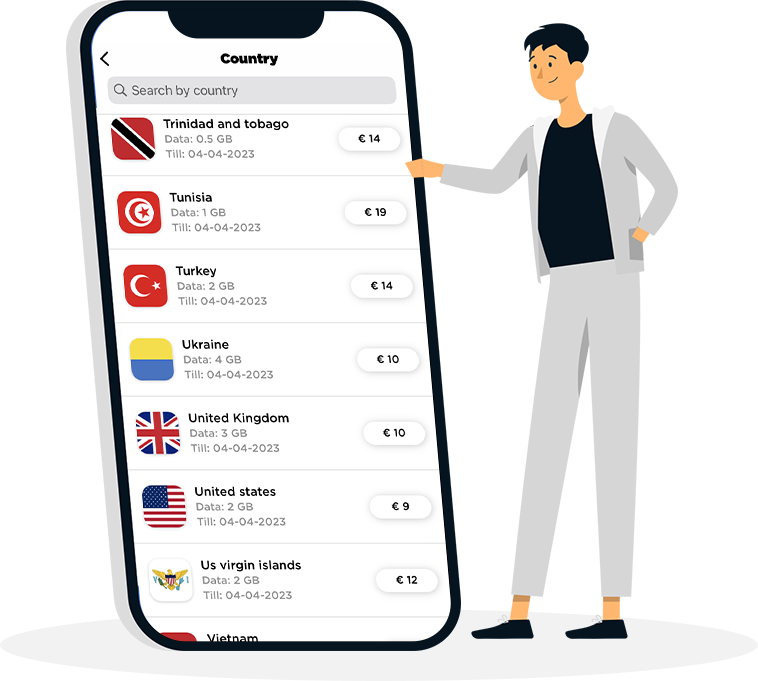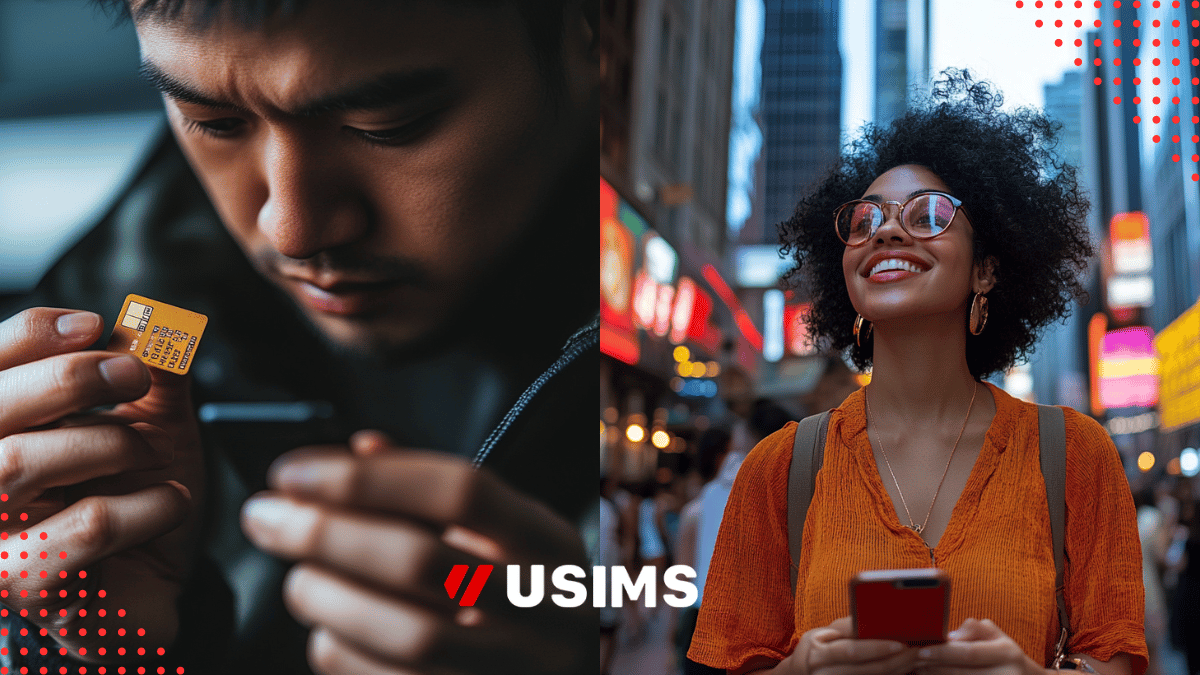Tired of buying new SIM cards and trying to find the pin to open your sim card slot? If you’re an avid traveler, you may have heard about eSIMs. Electronic SIM cards, or eSims, are one of the recent technological developments in the communications field. Let’s break down the pros and cons of eSIMs vs. Physical SIMs so that you can make an informed decision on your next trip abroad.
What is an eSIM?
An eSIM (embedded SIM) is a digital SIM that allows you to activate a cellular plan from your carrier without using a physical SIM card. It’s built into your device and can store multiple network profiles, making it a game-changer for international travelers.
Pros of eSIMS:
1. Convenience
•Instant Activation: Purchase and activate an eSIM directly from your phone without visiting a store or waiting for a physical SIM to arrive in the mail.
•Easy Switching: Toggle between different carriers and regions in your settings—no need to physically swap SIM cards or restart your phone.
One of the biggest advantages of digitizing the SIM card is that users can simply purchase and activate an eSIM on their phone, saving the time and effort of finding a store that sells SIM cards or waiting for a physical one to arrive in the mail. Moreover, switching between providers and regions can be as simple as toggling a button in your settings, as opposed to opening up your SIM tray, replacing the physical SIM card, and restarting your phone. This convenience is a significant factor in the eSIMs vs. Physical SIMs debate.
2. Flexibility
•Multiple Profiles: Store multiple eSIM profiles on one device, allowing you to switch between personal and business numbers or different regional carriers.
•International Roaming: Easily add a local data plan when traveling abroad while keeping your primary number active.
With eSIMS, users can store multiple accounts on one device, making it easier to switch between phone numbers when traveling internationally. This is especially relevant for those frequent travelers or international business people who need to stay in contact while abroad. In terms of eSIMs vs. Physical SIMs, this flexibility can be a game-changer.
3. Environmentally-friendly
•Reduced Plastic Waste: Eliminates the need for physical SIM cards, which contribute to plastic waste.
•Lower Carbon Footprint: Decreases emissions associated with manufacturing and shipping physical SIM cards.
Using an eSIM means no plastic waste from a physical SIM card. While the chip itself may seem small, the tossable nature of a traveling SIM card means buildups of plastic waste over the years. Not to mention, there is additional waste produced in the packaging and shipping process of physical SIM cards. This environmental consideration is a key point in the eSIMs vs. Physical SIMs discussion.
Cons of eSIMs:
1. Compatibility measures
•Device Limitations: Not all devices support eSIM technology, especially older models.
•Operating System Restrictions: Some mobile operating systems haven’t fully adopted eSIM functionality.
Solution: Check your device’s compatibility before planning to use an eSIM. Most recent models from Apple, Samsung, and Google support eSIMs.
Since eSIMs are still a relatively new technological advancement, they aren’t well suited for all types of phones. That being said, they do cover a wide range of devices, including the past five generations of iPhones, Samsungs, and Google Pixels. Some users may encounter issues with compatibility if they have an older device or are using certain mobile operating systems which have yet to adopt the technology. This can be a drawback when considering eSIMs vs. Physical SIMs.
2. Learning curve
•Installation Process: Setting up an eSIM may require scanning QR codes or entering activation codes, which can be unfamiliar to some users.
•Technical Knowledge: Less tech-savvy individuals might find the process challenging.
Tip: Follow the step-by-step instructions provided by your eSIM provider or seek assistance from customer support.
Although most eSIM companies provide relatively thorough instructions on how to install and activate an eSIM, there is still a slight learning curve. The process may require some technical knowledge and coordination with mobile operators. This means those who are less technologically savvy may have a harder time making the switch. Physical SIM cards have been around for a long time, which means mobile users are already familiar with the initiation process. This learning curve is a factor to consider in the eSIMs vs. Physical SIMs debate.
3. Switching between phones is more complex
•Reactivation Required: Transferring an eSIM to a new device often involves deactivating it on the old device and reactivating it on the new one.
•No Physical Transfer: Unlike physical SIMs, you can’t simply move the eSIM to another phone.
Consideration: Plan your device upgrades carefully and allocate time for eSIM setup on the new device.
While switching from region to region may have become easier, switching devices is a bit more complicated with an eSIM. With physical SIM cards, users just have to pop up the SIM tray and insert it into their new device. With eSIMs, users have to undergo the installation and activation steps on their new phone and deactivate it on their old phone. This process is still relatively straightforward for the tech-savvy, but not as intuitive for others. Luckily, switching devices is less of a frequent need than switching between networks or regions while traveling. This complexity is another point to consider in the eSIMs vs. Physical SIMs discussion.

eSIMs vs. Physical SIMs: Which is Right for You?
Choose an eSIM if:
•You own a compatible device.
•You frequently travel internationally.
•You prefer digital solutions and minimal physical clutter.
•Environmental impact is important to you.
Stick with Physical SIMs if:
•Your device doesn’t support eSIM technology.
•You prefer traditional methods.
•You rarely switch carriers or travel abroad.
•You find comfort in the familiarity of physical SIM cards.
Frequently Asked Questions
Can I use both an eSIM and a physical SIM on the same device?
A: Yes, many modern smartphones support dual SIM functionality, allowing you to use an eSIM and a physical SIM simultaneously.
How do I know if my device is eSIM compatible?
A: Check your phone’s specifications on the manufacturer’s website or consult your user manual. Devices like the iPhone XS and newer, Google Pixel 3 and newer, and recent Samsung Galaxy models typically support eSIM.
Is it safe to use an eSIM?
A: Absolutely. eSIMs are secure and use the same standards as physical SIM cards to protect your data and privacy.
Do eSIMs cost more than physical SIM cards?
The cost depends on the carrier and the plan you choose. Some providers offer competitive pricing for eSIM plans due to lower overhead costs.
Can I switch carriers with an eSIM?
A: Yes, one of the benefits of eSIMs is the ease of switching between carriers without needing a new physical SIM card.
Want to learn more about how eSIMs can enhance your travel experience? Visit our Frequently Asked Questions (FAQ) page for detailed answers and additional information.

All in all, the rise of eSIMs proves to be a step forward in convenience, environmental impact, and flexibility — all of which are important in an ever-evolving tech landscape. The cons of eSIMs are often what come with advancements in technology. Moreover, physical SIM cards are still around and available for those who are not yet convinced to switch. Ultimately, the choice to switch to eSIMs vs. Physical SIMs depends on each person’s preferences and devices. Both options are likely to coexist for the foreseeable future, providing international travelers with various connectivity solutions to suit their specific needs.
Above all, eSIMs provide a level of reliability that traditional SIM cards and local carrier international plans struggle to match. Whether navigating unfamiliar streets, staying in touch with loved ones, or accessing essential travel information, eSIMs ensure consistent connectivity with minimal downtime.



